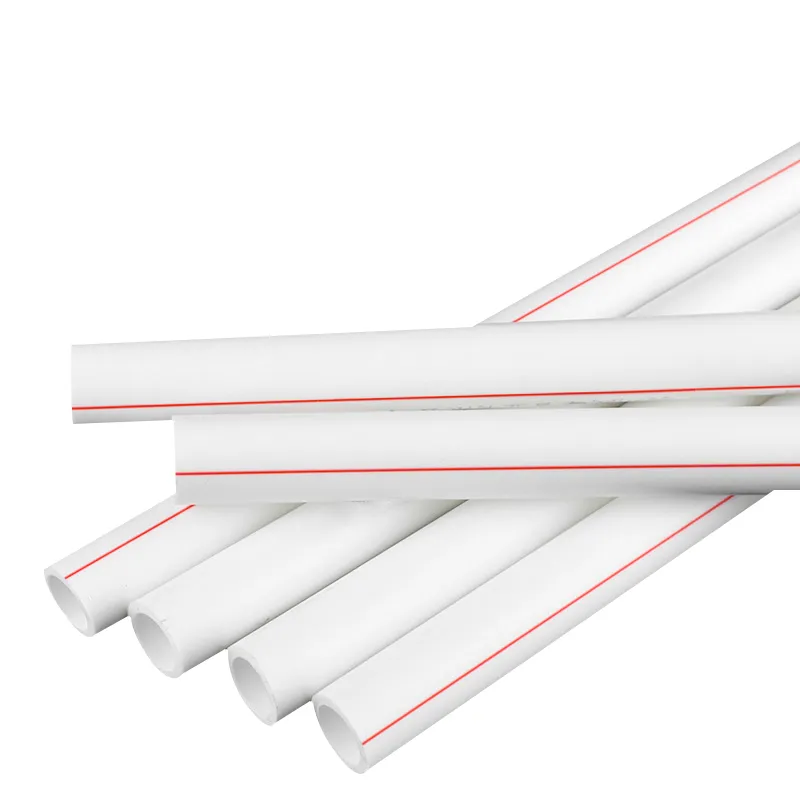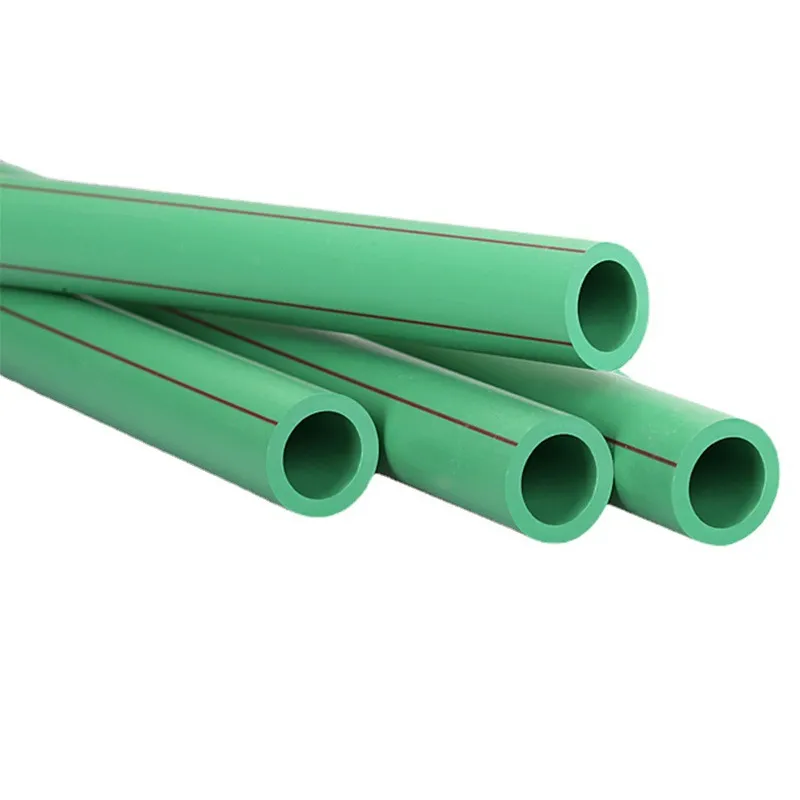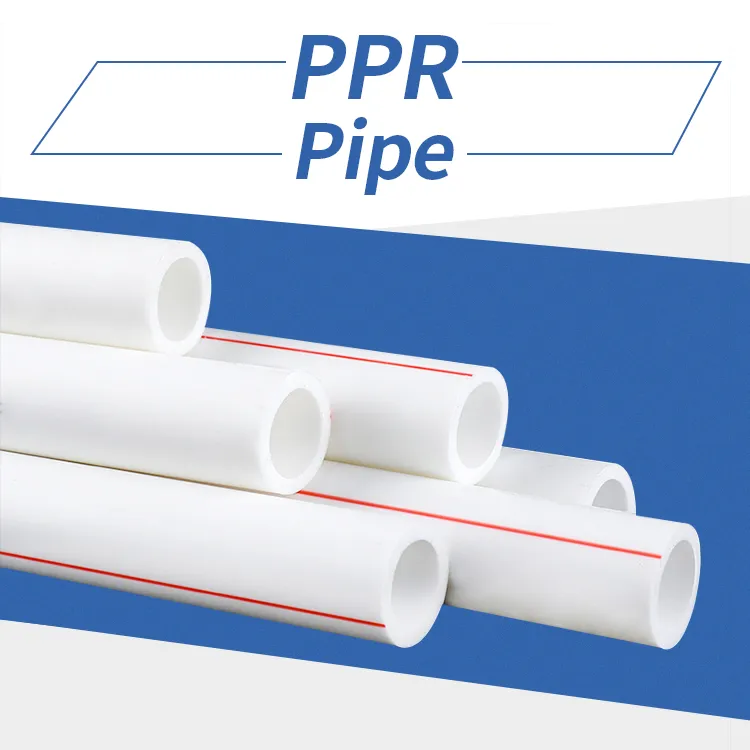
Common specifications of PPR hot water pipes: Ф20×2.8 Ф20×3.4 Ф25×3.5 Ф25×4.2 Ф32×4.4
The colors are usually: grey, white and green. The tube identification line is red.
PPR hot water pipe picture, white pipe with red marking line

PPR hot water pipe picture, green pipe with red marking line
How much pressure can the PPR hot water pipe withstand?
The pressure of the PPR water pipe depends on the S grade, such as the S4 series, then the nominal pressure is 1.6mpa, which is 16kg of pressure.
The nominal pressure of S5 type PPR pipe (C=1.25) is Mpa1.25
The nominal pressure of S4 type PPR pipe (C=1.25) is Mpa1.6
The nominal pressure of S3.2 type PPR pipe (C=1.25) is Mpa2.0
The nominal pressure of S2.5 type PPR pipe (C=1.25) is Mpa2.5
PPR hot water pipes are generally used as heating connecting pipes, and can also be used for hot water pipes of water heaters. Because of their high temperature and high pressure resistance, they are often used as home improvement pipes; PPR is a random copolymer of propylene and ethylene, and PP-R pipes are It is made of PP-R resin by extrusion. We have Complete PPR hot water plumbing pipe specification in China.
What are the characteristics of PPR insulation pipe
1. Good stability: good temperature resistance and heat preservation, thermal conductivity is only 1/200 of that of steel pipe, generally no heat insulation treatment is required; in addition, the elastic modulus is small, and the expansion force caused by temperature changes is relatively small Small, suitable for embedded wall and direct burial under the floor.
2. Smooth water supply: the inner wall is smooth, the system pressure is small, and the fluid resistance is small, so the flow rate is large and the speed is fast.
3. Long service life: Advanced technology and high-quality raw materials make PP-R pipes have strong anti-aging characteristics. The product can be used for a long time under the conditions of 8400h, 95°C and pressure of 0.82MPa, and the service life can reach more than 50 years.
4. The connection is firm and never leaks: the same material is fused together by welding. The tensile, bending and impact strength of the joint is higher than the strength of the pipe body itself, so as to eliminate the hidden danger of water seepage at the joint. Generally, no maintenance is required after installation. However, places near heat sources, metal sharp objects or instruments need to be checked frequently to see if the outside of the pipe is damaged.
PPR Hot Water Plumbing Pipe Specification
PPR (Polypropylene Random) pipes are widely used for hot water plumbing systems due to their excellent heat resistance and durability. Here are some common specifications for PPR hot water plumbing pipes:
Material: PPR pipes are made from high-quality polypropylene random copolymer (PPR-C) material. The material is specifically designed to withstand high temperatures and provide long-term performance.
Size: PPR hot water plumbing pipes are available in various sizes, typically ranging from 20mm to 110mm in diameter. The specific size needed for a project depends on the flow rate and requirements of the hot water system.
Pressure Rating: PPR pipes have different pressure ratings to accommodate various applications. Common pressure ratings for hot water plumbing pipes include PN10 (1.0 MPa), PN16 (1.6 MPa), and PN20 (2.0 MPa). The pressure rating indicates the maximum pressure the pipe can handle.
Color: PPR hot water plumbing pipes are usually available in green or white color. The color coding helps to differentiate between hot water and cold water pipes within the plumbing system.
Connection Types: PPR pipes can be connected using different methods, including socket fusion, butt fusion, and electrofusion. Socket fusion is a common method where the pipe ends are heated and joined together using a socket fusion welding machine.
Standards: PPR hot water plumbing pipes should comply with relevant standards and regulations in the specific region or country. Common standards for PPR pipes include DIN 8077/8078 (Germany), ISO 15874 (International), and ASTM F2389 (United States).
Temperature Range: PPR hot water plumbing pipes are designed to withstand high temperatures. They can typically handle hot water temperatures up to 95°C (203°F) for continuous operation. However, the specific temperature limits may vary based on the manufacturer and the standard followed.
PPR Hot Water Pipe Specifications
Frequently Asked Questions (FAQ) - PPR Hot Water Pipe Specifications
Q: What material is the PPR hot water pipe made of?
A: PPR hot water pipes are made of high quality polypropylene random copolymer (PPR-C) material. The material is specifically designed to withstand high temperatures and provide long-term performance.
Q: What sizes of PPR hot water pipes are available?
A: PPR hot water pipes are available in different size options, usually ranging from 20mm to 110mm in diameter. The size required for a specific project depends on the flow and requirements of the hot water system.
Q: What is the pressure bearing capacity of PPR hot water pipes?
A: PPR hot water pipes have different pressure ratings to suit various applications. Common pressure ratings for hot water pipes include PN10 (1.0 MPa), PN16 (1.6 MPa) and PN20 (2.0 MPa). The pressure rating indicates the maximum pressure the pipe can withstand.
Q: What is the color of the PPR hot water pipes?
A: PPR hot water pipes are usually available in green or white. Color coding helps distinguish hot and cold water pipes in plumbing systems.
Q: Which connection method can be used for PPR hot water pipes?
A: PPR hot water pipes can use a variety of connection methods, including socket fusion, butt welding and electrofusion connection, etc. Socket fusion is a commonly used method by heating the pipe ends and joining them together using a socket fusion welding machine.
Q: What standards do PPR hot water pipes need to meet?
A: PPR hot water pipes should comply with the relevant standards and regulations of a specific region or country. Common PPR pipe standards include DIN 8077/8078 (Germany), ISO 15874 (international) and ASTM F2389 (USA), etc.
Q: What is the temperature range of PPR hot water pipes?
A: PPR hot water pipes are designed for high temperature resistance. They are typically capable of handling hot water temperatures up to 95°C (203°F) in continuous operation. However, specific temperature limits may vary by manufacturer and by the standards followed.
Before selecting PPR hot water pipes, it is recommended to consult a professional plumbing engineer or supplier to ensure that the selected pipe meets the specific requirements of the project. They can provide details on available sizes, pressure ratings and installation guidelines.
If you want to purchase more specifications of PPR hot water plumbing pipe, please contact us.









659.webp)
210.webp)
328.webp)

294.webp)
476.webp)


